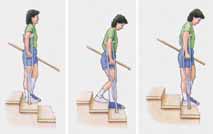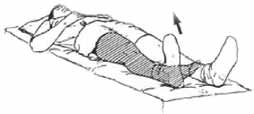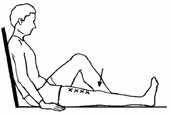Physical Therapy After Total Knee Replacement
Full recovery from your total knee replacement surgery is going to take several months. Guidelines are included which discuss precautions to protect you new knee joint, exercises that increase your knee strength and range of motion, and activities of daily living that will help you become an active partner in your care and recovery.
Guidelines to Protect Your New Knee Joint
It is very important to KEEP YOUR KNEE STRAIGHT WHILE RESTING, never place a pillow under the back of your knee. Place your heel on a rolled up towel, ottoman, or chair so air is under the knee, push the knee down in extension. This is the most important stretch or exercise after knee replacement, this will help you regain full extension.
We encourage you to walk, get outside, and work on your motion. We strongly encourage the use of ice for the first few weeks after surgery. You will receive a polar care or ice machine which cools the knee which is particularly helpful after therapy.
Lying in Bed: You may lie on either side. Remember never to put a pillow under your knee. Keep your knee out straight while lying down.
Sitting in a Chair: Use a firm, sturdy chair with arm rests.Allow your foot to rest on the floor if you can. Use a cushion or pillow to raise you up, if needed, to facilitate getting out of the chair.
Walking: YOU MAY PLACE ALL OF YOUR WEIGHT ON YOUR KNEE. The physical therapist will teach you to use a walker or crutches when you walk until your knee heals. Most people are walking normally after 3 weeks. Most only use crutches to provide balance and to ensure a normal gait in the first few weeks of recovery. Once a normal gait is established you may discontinue using your crutches, cane, or walker.
Your balance might be shaky for a while, we recommend that you:
- Use handrails on steps.
- Use low-heeled or flat shoes.
- Avoid wet or waxed floors.
- Keep your floors free of items that could trip you. Throw rugs or small objects should be kept off of the floor for your safety.
- Watch for pets or other animals that could get in your way.
- Avoid ice or snow.
Showering: You may shower immediately after surgery. The dressing has an antimicrobial seal and is safe for showering. However do not soak the incision in a tub or hot tub for 4 weeks.
Driving: If you are riding in a car the first couple weeks after surgery, stop every hour or so to get out and walk around for a few minutes. This will help the circulation in your legs and keep your muscles from stiffening up. Check with Dr. Hickman when you can resume driving after your surgery. Driving is usually allowed once the patient is off narcotic pain medications and normal foot and lower extremity reaction times return.
Physical Therapy: It is important to start physical therapy as soon as possible after you go home from surgery (most patients start within one week of surgery). Call a physical therapy office to set up an appointment, you will be given a prescription for therapy when you leave the hospital. Select patients may need home therapy or to go to a rehab center, Dr. Hickman and the discharge planner will help with this decision.
Managing Activities of Daily Living Following Your Knee Replacement
Chair Transfers: Avoid low recliners and soft couches until otherwise told by Dr. Hickman. Stiff-backed chairs with armrests are ideal to sit in. If the seat is low, you may place 1 or 2 pillows in the chair to elevate the seat and facilitate transfers.
- Back up to the chair until you feel both legs touching the chair.
- Slide your operated leg out in front of you as you reach back with one hand for an armrest.
- Lower yourself slowly, keeping your operated leg straight out. Once seated, bend your knee comfortably, or keep it straight.
- When getting up, scoot your operated leg out in front of you until you can stand on it comfortably.
- Push up using the armrests, keeping your operated leg out in front of you.
Car Transfers: The front seat is preferable because it generally has more leg room, can be adjusted for comfort, and can allow the rider to more easily wear a seat belt.
- Make sure the seat is as far back as possible. Back up to the car with your walker or crutches. Put your operated leg out in front of you.
- Lower yourself slowly to the seat. You may roll the window down and use the car door frame, along with the headrest, to support yourself as you sit.
- Scoot back into the seat, then swing your legs into the car. If the seat is low, recline the back slightly or put a pillow on the seat to sit on.
- To get in the back seat in a semi-reclining position. You will need to use your arms and non-operative leg to scoot yourself back farther onto the seat.
Adaptive Equipment
After your total joint replacement, you may benefit from several pieces of equipment to make your daily activities easier and safer. Dr. Hickman and physical therapist will recommend the equipment that best suits your needs.Most patients need very few assist aids after surgery. Some aids may be recommended depending on your particular needs which are assessed in the hospital.

Seat / Shower Bench: This seat allows you to sit while bathing and provides you safety while you are in the shower.
Seat Cushion: Cushions are used to elevate the seat height of a chair, couch, car, or other surfaces.

Elevated Toilet Seat: This device is attached to your toilet seat to elevate its height.
Long-Handled Shoe Horn: This shoe horn is attached to a long stick and allows you to put on your shoes while sitting or standing.
Walking with Crutches
Crutch Safety
- The pressure or weight goes on your hands and not on your armpits. Nerve damage can result if weight is placed on the armpits for a long period of time.
- Keep your elbows close to your side to help keep the crutches against your ribs.
- Your crutch tips should be 2 to 3 inches out to the side of your feet so you do not trip on your crutches
- There should be a slight bend in your elbow when holding onto the crutches (15 to 20 degrees).
- Take your time and do not try to walk too fast.
- Keep your head up and look ahead. Do not look at your feet when walking.
- When walking on carpet, you must pick up your crutches and injured leg more than when you walk on tile or linoleum floors.
- Remove all throw rugs from the floor to keep from slipping and falling.
Going up with Handrail
- Place both crutches under your arm on the injured side.
- Grasp the handrail with your other hand, if possible.
- Keep the crutches on the stair you are standing on.
- Support your weight between your crutches.
- Bring your good leg up to the next step. Let the injured leg trail behind.
- Straighten your good leg and bring the crutches and injured leg up.

Going Down with Handrail
- Put the crutch on the lower step.
- Lower your injured leg down to the lower step.
- Support your weight between your crutch and handrail.
- Move your good foot to the lower step.
Exercises
The day of surgery, the physical therapist will get you out of bed and help you walk with a walker or crutches as you are able. You will also start sitting in a chair for 15 to 30 minutes at a time. Before you go home, the physical therapist will teach you how to climb stairs safely to protect your new knee. They will also teach you basic exercises and send you home with a home exercise program. Exercise will help you regain the strength in your knee and legs so you can walk more easily.
Additionally, you may perform isometric exercises in bed right after your surgery to help you begin to recover. Isometric exercises will help your muscles begin to “wake up” after surgery and will help to promote circulation in your legs to prevent blood clots from forming. They may be performed throughout the day whenever you feel your legs becoming stiff. Remember to breathe in as you tighten your muscles, and out as you relax them. Breathe normally while you hold the position.You will need to start outpatient physical therapy as soon as possible (usually within one week of surgery).
The most important exercise or stretch after surgery is to work on your extension (getting the knee flat or straight). This should be done by placing your heel on an ottoman, chair, or on a rolled up pillow so air is under the knee, then push the knee down in extension. You should also work on flexion (the bend).
Below are some basic beginning exercises that should be performed until you can do 3 sets of 10 repetitions very easily. An advanced set of exercises is provided for when the beginning exercises are too easy. Remember to start outpatient physical therapy as soon as possible after you go home (usually within one week of surgery). Your physical therapist will help guide you through these and other exercises.
Ankle Pumps: This strengthens your calf muscles in your lower leg.

- Lie on your back.
- Bend your ankle and pull your foot and toes towards your head.
- Push your foot back down and point your toes away from you as far as possible, like you are pushing on the brake pedal of a car.
- Repeat with both legs 10 times every 2 hours throughout the day.
Quad Setting: This exercise helps your upper leg or thigh muscles.

- Tighten the muscles of your thigh.
- Keep your knees straight. Push your knee down into the bed, having your kneecap move upward toward your hip.
- Think about trying to raise your heel ½ inch off the bed.
- Hold for a count of 5 and then relax.
- Repeat with the other leg.
- Alternate legs for 10 repetitions on each side 3 times a day.
Gluteal Setting
- Squeeze your buttocks together. Hold for a count of
- Relax and repeat. Perform a total of 10 repetitions 2 times a day.
Straight Leg Raise: This exercise works the muscles of the upper leg and thigh.
- Keeping your knee as straight as possible, lift your leg off of the bed about 12 inches.
- Lower the leg slowly back to the bed.
- Relax and repeat.
- Perform 30 repetitions; resting as needed.
Knee Straightening Over a Pillow: This exercise works the muscles of the lower thigh and will help out walk without limping.
- Place a rolled up pillow or towel under the operated knee.
- While your knee remains on the pillow, lift your foot up, straighten the knee, and point the foot toward the ceiling.
- Slowly lower your foot back to the bed.
- Relax and repeat.
- Perform 30 repetitions; resting as needed.
Knee Bending: This exercise helps to improve the range of motion of your new knee.
- While sitting in a high chair, hang your leg freely to let gravity bend your knee. If this is too painful, let your foot rest on the floor and slide your heel back along the floor.
- Bend the leg back under the chair as far as possible.Straighten the leg back out in front of you.
- Relax and repeat.
- Perform 30 repetitions; resting as needed.
Another way to perform this exercise is as follows:
- Sit in a chair with both feet flat on the floor.
- Bend your operated knee, slide your foot back and plant your heel firmly on the floor.
- While keeping your feet in place, slide your hips forward to the edge of the chair and hold for 10 to 30 seconds.
- Slide your hips back in the chair and relax.
- Repeat 10 times.
Stationary Bike: It is okay to start riding a stationary bike without resistance immediately after surgery. You can start by doing small semicircles with your operative knee straight down. Slowly rock the pedal back and forth causing your knee to bend. Gradually work towards a full circle. Make sure the amount of motion as well as the amount of time you spend on the bike starts at a low level and slowly increases. Monitor your pain and swelling closely and cut back if either increases significantly.
Avoiding Problems After Surgery
KEEP KNEE STRAIGHT WHEN RESTING - NEVER PLACE A PILLOW UNDER THE BACK OF KNEE - place your foot on an ottoman, chair, or on a rolled up pillow so air is under the knee, push the knee down in extension this is THE MOST IMPORTANT STRETCH OR EXERCISE after knee replacement.
WORK ON THE BEND - slide the foot under the chair, stretch the bend.
Blood Clot Prevention: Follow your orthopaedic surgeon's instructions carefully to minimize the potential of blood clots which can occur during the first several weeks of your recovery.We are very aggressive in minimizing the risks of clots and have been successful in significantly decreasing the risks of clots.
Warning signs of possible blood clots in your leg include:
- Increasing pain in your calf.
- Tenderness or redness above or below your knee.
- Increasing swelling in your calf, ankle and foot.
Warning signs that a blood clot has traveled to your lung include:
- Sudden increased shortness of breath.
- Sudden onset of chest pain.
- Localized chest pain with coughing.
Notify Dr. Hickman immediately if you develop any of these signs.
Preventing Infection : The most common causes of infection following total knee replacement surgery are from bacteria that enter the bloodstream during dental procedures, urinary tract infections, or skin infections. These bacteria can lodge around your knee replacement and cause an infection.
Following your surgery, you should take antibiotics prior to dental work or any surgical procedure that could allow bacteria to enter your bloodstream.
Warning signs of a possible knee replacement infection are:
- Persistent fever (higher than 100 degrees orally).
- Shaking chills.
- Increasing redness, tenderness or swelling of the knee wound.
- Drainage from the knee wound.
- Increasing knee pain with both activity and rest.

